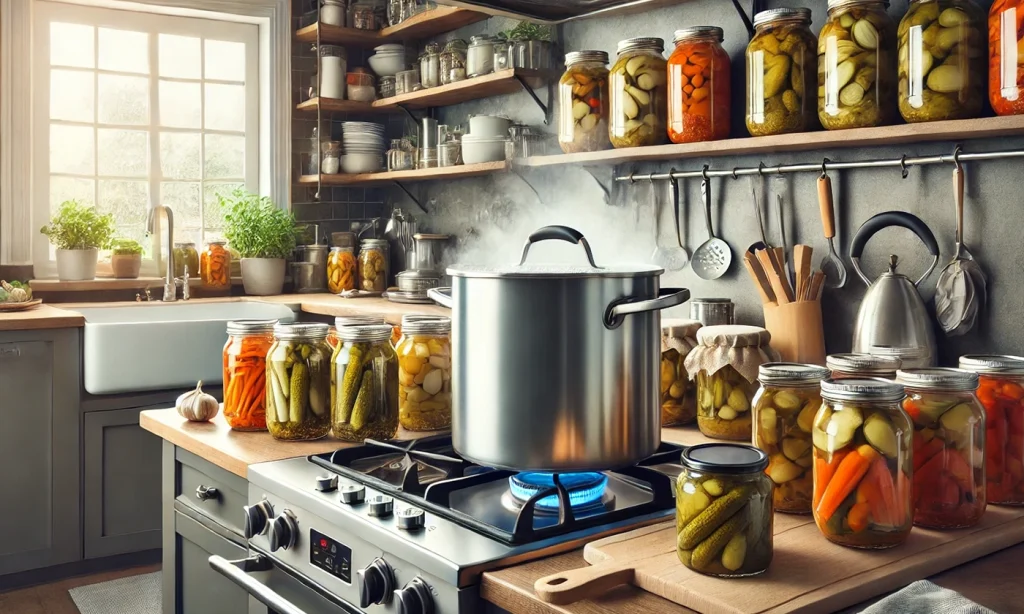Water Bath Canning: Step-by-Step Instructions

Learning the ins and outs of water bath canning opens up a realm of delicious possibilities. This simple yet effective method lets you preserve high-acid foods like pickles, jams, and salsas, ensuring they’re safe and ready to enjoy anytime. By submerging jars in boiling water, you create a vacuum seal that locks in freshness while keeping harmful bacteria at bay.
Water bath canning is perfect for beginners and seasoned preservers alike. It involves placing your filled jars in a large pot, covering them with water, and boiling for a set time. This process not only kills spoilage-causing organisms but also ensures a tight seal, keeping your homemade goodies shelf-stable.
With just a few basic tools and some know-how, you’ll be on your way to stocking your pantry with flavorful, homemade preserves. Whether you’re new to canning or looking to refine your skills, mastering water bath canning is a rewarding and practical endeavor.
Key Takeaways
- Water bath canning is a straightforward food preservation method, used primarily for high-acid foods like jams, pickles, and salsas.
- The process involves submerging filled jars in boiling water to create a vacuum seal, which locks in freshness and prevents spoilage.
- Essential tools for successful water bath canning include a large pot or canner, jar lifter, funnel, lid lifter, and timer.
- Proper preparation includes cleaning and sterilizing jars and lids, and ensuring accurate headspace and air bubble removal inside the jars.
- Following precise timing and temperature guidelines is crucial to ensure food safety and achieve effective preservation.
- Properly sealed jars should be stored in a cool, dark place, and spoiled canned foods should be identified and discarded to avoid health risks.
What Is Water Bath Canning?
Water bath canning is a food preservation method used to keep high-acid foods fresh and safe. By placing jars in boiling water, you create a vacuum seal that effectively protects the contents from spoilage.
How It Works
In water bath canning, you ensure jars are completely covered with water in a large pot known as a water bath canner. The water is heated to a boiling temperature of 212 degrees Fahrenheit (100 degrees Celsius). This heat effectively removes oxygen and kills harmful bacteria, yeasts, and enzymes. During the process, the expansion of food in each jar pushes out air, resulting in a vacuum seal that tightly secures the lid.
Benefits of Water Bath Canning
- Safety: High-acid foods with a pH lower than 4.6 are safely preserved.
- Shelf Stability: Creates a vacuum seal which allows foods to be stored without refrigeration.
- Simplicity: Ideal for beginners due to its straightforward process using basic kitchen equipment.
- Versatility: Suitable for a variety of foods, such as jams, jellies, and pickles.
Equipment and Materials Needed
For successful water bath canning, gather essential equipment and materials to ensure safety and efficiency.
Essential Equipment
- Large Pot or Canner: Use a pot deep enough to fully submerge your jars. Ensure it also includes space for water to remain at a rolling boil.
- Jar Lifter: A secure-grip jar lifter is crucial for safely removing hot jars from boiling water. This specialized tool prevents accidents.
- Funnel: A nonreactive funnel assists in filling jars without spills. This prevents messes and maintains cleanliness.
- Lid Lifter: A magnetic lid lifter helps retrieve lids from hot water. It reduces direct hand contact with heat and maintains hygiene.
- Timer: Accurate timing is vital for processing. Use a reliable timer to follow recipe times precisely.
Optional Tools
- Bubble Remover: A bubble remover eliminates trapped air bubbles in filled jars. This helps ensure a reliable seal.
- Kitchen Towels: Clean kitchen towels are useful for wiping jar rims and providing a clean, soft surface for cooling jars.
- Food Mill: If making sauces, jams, or fruit butters, a food mill helps create smooth textures. This tool can facilitate even processing.
Selecting the Right Jars and Lids
Select various jar sizes such as 4 oz (half-pint), 8 oz (pint), or 16 oz (quart) to match your canning needs. Reuse jars without chips or cracks to ensure integrity. Replace lids and rings as necessary to guarantee an effective seal. Choose between reusable dimpled lids or canning lids, which typically include a flat lid and screw band. Canning lids are usually single-use, while rings are reusable. Keep in mind, reusable canning lids are available if preferred.
Preparing for Water Bath Canning
Clean and Sterilize Jars and Lids
Sterilizing your canning jars is crucial to ensure safe food preservation. Begin by inspecting each jar for cracks or chips, as damaged jars may lead to breakage or seal failure. Use warm, soapy water to wash jars, bands, and lids. Rinse well and dry thoroughly. Place the jars in a water bath canner filled halfway with water, keeping the temperature around 180°F to maintain a simmer. Preheat the jars to prevent breakage during the canning process. Keep lids and bands at room temperature to facilitate easy handling, ensuring the underside of lids remains free from scratches to achieve an effective seal.
Prepare the Recipe or Food
Before the canning process, prepare your chosen recipe by following guidelines for jar size, preserving method, and processing time. Use a canning-specific funnel to fill hot jars with food, leaving the recommended headspace as noted in your recipe. Remove air bubbles to secure a proper vacuum seal by gently sliding a non-metallic spatula between the jar interior and its contents. This step minimizes seal interference and prevents spoilage. Adjust seasoning if necessary, as some flavors intensify during preservation. Once the food is ready and jars are filled, continue with your water bath canning method to preserve the freshness and quality of your homemade foods.
Step-by-Step Water Bath Canning Process
Follow these precise steps to achieve successful water bath canning, ensuring safe and delicious preserved foods.
Step 1: Fill the Canning Jars
Fill each preheated canning jar with prepared food using a funnel. This will help prevent spillage and maintain cleanliness. Leave the recommended headspace from the top of the food to the rim of the jar as stated in your specific recipe. Sufficient headspace is essential to allow for food expansion and to ensure a proper seal.
Step 2: Release Air Bubbles
To ensure proper sealing, release trapped air using a bubble remover or rubber spatula. Insert the tool between the food and jar walls, then move it along the circumference of the jar 2-3 times. Air bubbles affect the vacuum seal, so this step is crucial for preserving quality.
Step 3: Wipe Rims and Apply Lids
Wipe the rims and threads of the jars with a clean, damp cloth to eliminate residue. Place a canning lid on each jar, ensuring the sealing compound contacts the rim evenly. Secure with a metal band, adjusting to be fingertip-tight. An adequately cleaned rim improves the chances of achieving a strong seal.
Step 4: Process the Jars in Canner
Position the jars in a water bath canner, using a jar lifter to prevent accidents. The water should cover the jars by at least 1 inch (2.5 cm). Cover the canner and bring the water to a rolling boil. Process the jars for the time specified in the recipe. This ensures food safety by eliminating spoilage organisms.
Step 5: Cooling and Testing Seals
Carefully remove the jars from the canner using the jar lifter. Place jars on a clean towel to cool for 12-24 hours, away from drafts. As jars cool, the lids should “ping” to signal sealing. To test seals, press the center of each lid. If the lid does not flex up and down, it is sealed correctly. Store sealed jars in a cool, dark place.
These precise steps guide you through the water bath canning process, ensuring your preserved foods maintain quality and safety for shelf storage.
Labeling and Storage
Effective labeling and proper storage methods ensure the quality and longevity of your canned goods. Explore these essential steps to maintain the safety and taste of your preserves.
Checking Seals
Verify the seal integrity on each jar by pressing the center of the lid. If it pops back, the seal is not secure. Look for concave lids as a visual confirmation of a good seal. A tightly sealed jar prevents spoilage and extends shelf life. Always check seal quality within 24 hours after processing for maximum reliability.
Proper Storage Techniques
Store your labeled jars in a cool, dark, dry place, such as a pantry, to optimize preservation. Avoid areas with direct sunlight, high humidity, or temperature fluctuations, like near hot pipes or utility rooms. This environment helps maintain the quality of your canned food for up to one year. Avoid stacking jars to prevent compromising the integrity of the seals. Label each jar with its contents and the processing date to track freshness easily.
Common Canning Issues
Understanding potential issues in water bath canning is crucial for safe and effective preservation. Learn to manage seal failures and identify spoiled canned foods to ensure the quality of your preserves.
Resolving Seal Failures
Seal failures occur due to various reasons such as overfilling jars, damaged rims, or improper lid positioning. To resolve seal failures, check the following:
- Jar Filling: Maintain the recommended headspace to prevent overfilling, which can lead to food interfering with the seal.
- Rim Inspection: Before filling, ensure the jar rims are free of chips or nicks that could disrupt the sealing process.
- Lid Placement: After filling, wipe rims clean and position lids correctly by centering them, ensuring they are properly aligned.
- Temperature of Lids: Avoid lids that are too hot or too cold when placing on jars as this can impact sealing.
- Screw Bands: Tighten screw bands just until fingertip tight before processing and avoid adjusting after processing to prevent breaking the seal.
Reprocess jars with new lids within 24 hours or transfer contents to the fridge or freezer for temporary storage if any jars haven’t sealed properly.
Identifying Spoiled Canned Foods
Identifying spoilage is essential for food safety, especially in canned goods. Signs of spoiled canned foods include:
- Lid and Jar Condition: Look for bulging lids or leaking jars as indicators of spoilage.
- Contents: Observe the presence of spurting liquid, mold, or unusual odors upon opening the jar.
- Visual and Tactile Tests: Press the lid center; it should not be pressable. A properly sealed jar has a concave lid.
Discard any jars showing spoilage signs without tasting to avoid health risks. A mold growth may raise the pH of high-acid foods, promoting the growth of harmful organisms. Always prioritize safety by inspecting each jar before consumption.
Water Bath Canning Tips and Best Practices
Maintain Proper Water Level
Keep the jars fully submerged in at least 2 inches of water to ensure a consistent temperature throughout processing and achieve a proper vacuum seal.
Monitor Processing Time and Temperature
Keep the water at a rolling boil throughout processing and adhere to the specified processing times for different foods. High-acid foods require boiling at 212°F (100°C) for effective preservation.
Inspect Equipment Routinely
Regularly check lids, jars, and bands for defects such as nicks or rust that could affect sealing. Replace any damaged items to prevent seal failure during canning.
Prepare Jars in Advance
Preheat jars in hot water at 180°F before filling them with hot food. Preheating helps prevent thermal shock and potential breakage upon contact with hot food.
Ensure Appropriate Headspace
Leave the specified headspace for each food type when filling jars to accommodate expansion and ensure a strong seal.
Remove Air Bubbles
Utilize a non-metallic tool to slide around the inside of the jar and release trapped air bubbles. This step is crucial for achieving a proper vacuum seal.
Wipe Jar Rims
Before sealing, wipe jar rims with a clean, damp cloth to remove any residue that could hinder sealing and compromise preservation.
Apply Lids and Bands Correctly
Place the lid and screw the band until fingertip-tight, which should be snug but not overly tightened, to allow for air escape during processing and ensure proper sealing.
Check and Store Sealed Jars Properly
After processing, test the seal by pressing the center of the lid; a concave, unyielding center indicates a good seal. Store sealed jars in a cool, dark, and dry place, and avoid stacking them to maintain seal integrity









